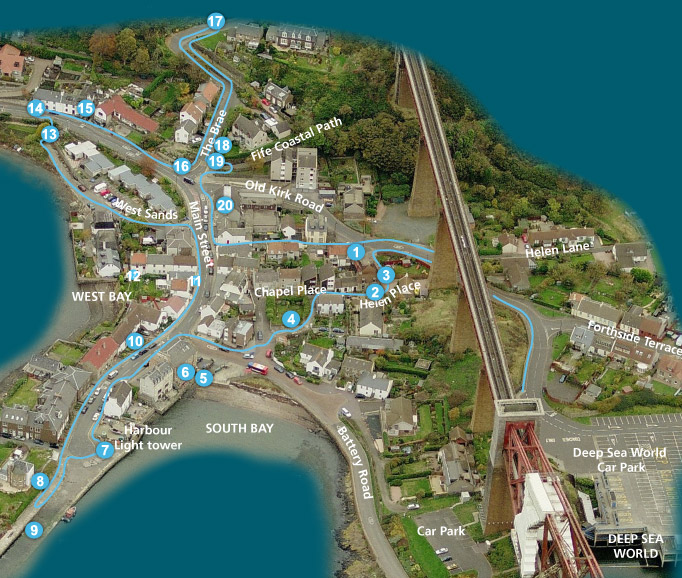Walks round the Village

Leaving the car park at Deep Sea World, pass under the Forth Bridge, and turn left into Helen Place.
Heron House [1] was once called Herring House – a barn converted to a fish gutting works. Fishing was an important industry in the village.
18th century Yoll Cottage [2] was once on the shore of South Bay (St James’s Bay.) The bay has been pushed back by infill from quarry workings.
Melinkie Cottage [3] was the village school, until it became too small for the growing population in the 18th century.
Follow Helen Place round to Chapel Place and St James’s Chapel [4]. In 1322 King Robert I granted the chapel to Dunfermline Abbey. In the 18th century, the North Queensferry Sailors’ Society converted it to a cemetery for their members. Round the corner, Battery Road led to the gun batteries which protected ships on the Forth.
Off the road is Cadger’s Slip [5] where fishermen landed their catch.
The Albert Hotel [6] gave shelter to travellers and had extensive stables for horse-drawn carriages.
Before the construction of the Harbour Light Tower [7] in 1817, the Signal House [8] was used as a navigational aid. Passengers waiting for a ferry could shelter downstairs in the Signal House, whilst upstairs was the office of Captain Scott, the first Superintendant of the Queensferry Passage. The ferries berthed at Town Pier [9], built by John Rennie in 1810, and also at the Battery Piers (beneath the Rail Bridge).
By 1828, new steam-powered ferries needed deeper water, and Thomas Telford extended the Town Pier to its present length. The Railway Pier (other side of West Bay) was opened in 1878 as the terminus of the new Dunfermline to North Queensferry Railway.
Walk back along Main Street, to Black Cat Inn [10] one of the oldest houses in the village. The initials TP and BC belong to the original owners Thomas Peastie and Bessie Creech. Behind the inn the shoreline was once the path of the King’s Way, the original road from the ferry to Dunfermline. Nearby is Ivy Cottage [11] which once faced the King’s Way, but with the building of the present Main Street, now faces east.
Round the corner, 10-16 Main Street, once formed Charlie Black’s Close [12] which led to the King’s Way. Just opposite the Ferrybridge Hotel, turn left, into West Sands, and follow the road (on the old King’s Way) round to Willie’s Well [13] which once provided water for the village.
Go up the steps and cross the road to another two old houses, White House [14] and Brae House [15]. The wall-mounted sundial, would have hurried travellers to the ferries.
Next to the War Memorial [16] is a stone trough, once used to water horses. If you climb half-way up The Brae, you will come to Jubilee Well [17] celebrating Queen Victoria’s reign. The less adventurous can cross the road to Lion’s Head Cistern [18] which feeds water to Waterloo Well [19].
At this point, follow the Fife Coastal Path. This will take you past the site of Carlingnose Quarry, a very important source of employment in the 19th century, and then on to Carlingnose Nature Reserve, with excellent views over the River Forth.
Alternatively walk back down Main Street, past Ferrybridge Hotel [20] once owned by a ferry boatman. Turn left into Post Office Lane and very soon you will be back under the Railway Bridge and the entrance to Deep Sea World.
Have fun exploring the village!
If you are feeling more adventurous, you can explore further afield walking round the peninsula.
Or strike out along the Coastal Path or Fife Pilgrim’s Trail.